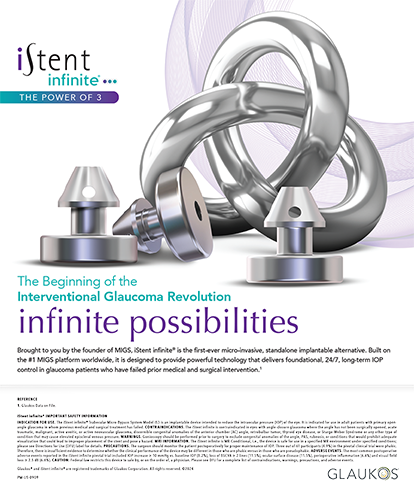Robert J. Cionni, MD, of Cincinnati, Ohio, a clinical investigator for the AcrySof Toric IOL (Alcon Laboratories, Inc., Fort Worth, TX), has implanted this lens at a rate of five per week since its FDA approval in September 2005 with excellent outcomes.
"The AcrySof Toric IOL has been very successful in my practice," said Dr. Cionni in an interview with Cataract & Refractive Surgery Today. "I would say, out of the patients to whom I offer this lens, about 80 to 90 of them get it. For those patients that say 'no,' it is usually because they are happy wearing glasses or they do not want to pay the increased costs for the special implant."
Although it is not difficult to learn the proper implantation procedure for this lens, Dr. Cionni stresses that there are particular steps that are important. The implantation procedure required for the AcrySof Toric IOL does not differ greatly from that of a typical IOL during cataract surgery. The only adjustments necessary include the calculations of cylindrical power and intended axis of placement, the marking of the eye, and the on-axis positioning of the lens.
THE IMPLANTATION PROCEDURE
The AcrySof Toric Calculator
According to Dr. Cionni, a surgeon must first learn how to use the AcrySof Toric IOL Calculator (available at www.acrysoftoriccalculator.com) in order to choose the correct lens model and the optimal axis location for the lens. The calculator takes into account the amount of astigmatism entered from the manual keratometry readings. A unique feature of the calculator is that it compensates for surgically induced astigmatism, thus making the overall calculation more precise. "You then enter the amount of induced astigmatism that patients typically get with your standard incision," said Dr. Cionni. "For example, my 3.0-mm incision typically induces 0.50 D of cylinder 90° from where I make the incision. Once that is done, the calculator will indicate which toric model is needed and the axis in which the AcrySof Toric IOL should be placed. As long as you orient the lens to the intended axis, you will achieve a great result."
Dr. Cionni says he posts a copy of the toric IOL calculator report he is using (oriented to the surgeon's operating microscope view) so that he can use it as a reference while operating.
Marking the Eye
Premarking of the reference vertical and horizontal axes should be performed with the patient sitting or standing to avoid cyclorotation of the eye. This is accomplished using a marking pen or a special reference axis marker. These marks are used as a reference during the surgery to properly orient an axis marker or Mendez ring used to mark the intended axes for both the incision and final IOL orientation.
Aligning the IOL
After inserting the lens into the capsular bag, the surgeon rotates the lens to a point 10° to 15° counter-clockwise of the desired final axis. Holding the IOL with a second instrument through the sideport incision during the viscoelastic's removal will help prevent it from over-rotating past the intended axis. Once the viscoelastic is removed, the surgeon rotates the lens to the proper axis for final alignment using the second instrument through the sideport while performing irrigation with the I/A handpiece.
RESULTS
According to Dr. Cionni, his results with the AcrySof Toric IOL have been very positive and predictable, as long as the lens is placed at the proper axis and the calculator is employed. "If the aforementioned pearls are followed, you have the ability to achieve minimal or no cylinder postoperatively," said Dr. Cionni. "I would say somewhere between 95 of patients and up that receive this lens will be spectacle free for distance after bilateral implantation."
"Every time a new technology comes out that can improve visual results, it means that we have greater potential to make our patients happier," said Dr. Cionni. "In today's world, our patients' expectations are higher than ever, so I urge surgeons to understand toric IOLs, learn how to use them, and incorporate them into their practices."
Robert J. Cionni, MD, is Medical Director of the Cincinnati Eye Institute in Ohio. He is an investigator, speaker, and consultant for Alcon Laboratories, Inc. Dr. Cionni may be reached at (513) 984-5133; rcionni@cincinnatieye.com.


